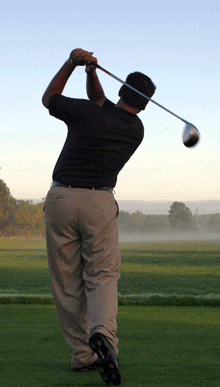
Newport Clinic
Floor 2 ( Room/Office No 7 ) Newport Market NP20 1DD
Tel: 075636 56666


OUT OF HOURS - 0800 074 3040 COLLECTIONS - 0800 074 3050 HOME VISITS - 029 2009 0089
Appointments: Monday - Friday 8.30 am - 7pm Saturday 8:30 am - 2 pm Sunday by request only

Care you can rely on
40 years of
5 STAR TREATMENTS



Golf Injuries
In their review of golf injuries and treatment, Herring and Pearson state that injury rates per golfer per year range from 1.19 to 1.31 with 37 percent of those injuries occurring in the low back or lower extremity.3 They presented a case study of one patient with heel pain who was treated with a combination of podiatric and chiropractic care. Daniels states that the most common golf-related foot injuries he sees are
Morton’s neuroma and
He says these injuries are caused by increased motion of the foot.
A study by Stude and Gullickson found that orthotics can increase balance and allow golfers to drive the ball farther.5 -
See more at: http://www.podiatrytoday.com/guide-common-foot-and-ankle-golf-injuries#sthash.meIXFXKC.dpuf
How To Recognize And Address Intermetatarsal Neuromas
The most common golf-related complaint is an intermetatarsal neuroma. It typically occurs in the third interspace and is almost always in the non-dominant foot. In other words, if the golfer swings the club right-handed, the neuroma occurs in the left foot and vice versa. This occurs due to the repetitive force placed on the nerve between the metatarsals as the momentum of the golf swing causes the forefoot to invert at the end of the golf swing.
The irritation of the nerve is more noticeable on longer shots such as a drive and is imperceptible on shorter shots like putts. As the forefoot inverts and the rearfoot supinates, the common interdigital nerve gets irritated within the third innerspace. This nerve unit then enlarges due to the irritation and the classical neuroma symptoms develop. These symptoms include burning, numbness and shooting pain into the toes.
The treatment options for this problem are the same as for any neuroma. They consist of NSAIDs, corticosteroid or alcohol sclerosing injections, orthotics and surgical intervention. One important treatment goal is to adjust the mechanics of the swing to decrease the inversion and supination of the foot. A 45-degree abduction of the front foot during ball address will decrease the inversion at the end of the swing and decrease the mechanical irritation of the nerve. Most of these golf-related neuroma cases resolve with a simple change in stance and minimal other treatment.
- See more at: http://www.podiatrytoday.com/guide-common-foot-and-ankle-golf-injuries#sthash.meIXFXKC.dpuf
Tired of Roughing It
"I first visited Michael Franklin at his Cardiff City Centre Surgery in December 2012 to have a look at my painful corns and calluses on the sides and soles/balls of my feet.
I have suffered from corns and calluses for a long time due to my long distance running and intensive badminton training regimes. Also, I sustained a bad sprain to my left peroneus longus and left tibialis anterior tendon whilst playing golf in May 2012, which had aggravated the growth of the corns and calluses on my feet during my injury rehabilitation.
I have tried, with little success, different kinds of over-the-counter pads and cushions to help alleviate the pain on my feet. I have also resorted to buying larger sized trainers and shoes with the thinking (sadly, erroneously!) that these will reduce the rubbing against the painful corns on my feet during walking and exercising. ..












